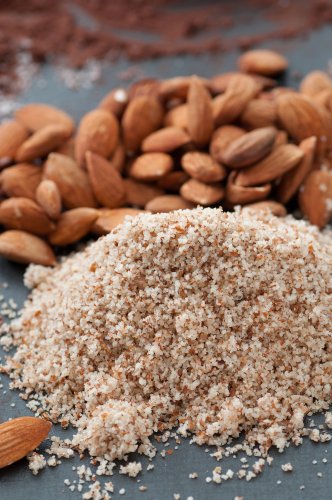Almond Flour
Almond flour is a flour made from whole almonds which have been blanched and ground. Blanching allows for the removal of the almond skins, which contain tannic acid. Tannic acid can inhibit digestion in some people, so blanching also improves the digestibility of the final product. Almond meal with the skins included can be used in recipes as well however. I've used it in my low carb bread recipes, and it gives a nice texture and visual appeal to the bread.
The flour made from almonds are is higher in protein and fiber, and lower in carbohydrates than traditional wheat and rice flours. In addition, when compared to traditional flours, flour from almonds is higher in important nutrients such as potassium, magnesium, niacin, calcium and iron.
Product Details and Differences
Flour made from almonds is not the same as almond meal. Almond meal is made from whole, raw almonds with the skins still intact. Using almond meal in place of almond flour for some recipes will give you weird results. The two terms are confused easily because some product manufacturers use both terms for the same product.
There are also differences in the quality of the various almond based flours available on the market. The difference is mostly in the grinding process.
Specifically, some manufacturers grind the almonds more finely than others. Honeyville brand makes a product which has a much finer grain. It is recommended for baked products such as cakes or muffins. You can purchase this product online, and it's a cheaper than buying it retail. As it becomes more popular, other brands have become available on Amazon and other online retailers such as Netrition.
Bob's Red Mill brand is more widely available, and can usually be found in your local grocery store. It used to have a coarser grind, so it worked better for recipes when you want a coarser texture and chewy mouth feel in the final product. But since 2017, I've seen that the packages now say "super fine" and the original coarser product doesn't seem to be available, at least on Amazon.
King Arthur offers a super finely ground almond flour, and there are now many other brands on Amazon to try. I tend to stick with Honeyville, because I know the product.
One very important fact to note is that nut flours don't contain gluten like regular wheat flour. Gluten provides the sticky stretchiness found in regular bread dough. Hence, baking with almond flour takes some ingenuity to get a final product that won't crumble from lack of cohesiveness. In my recipes, I start with a cream cheese/butter base to provide moisture and body, and in some recipes I've added whey protein powder or a gum product such as xanthum gum to hold the final baked product together. I've made pie crusts and tart crusts from almond flour and they turn out great. Check out my low carb appetizers page for some ideas.

Storing Almond Flour
Because almonds are a whole food and the fats in them are polyunsaturated, the flour can easily go rancid if not stored properly. Make sure you keep the almond products you buy in the refrigerator or freezer, especially if you live in a warm climate.
Fortunately, storing this flour is easy. It will keep in the freezer for more than 6 months. Be sure to store it in heavy duty freezer bags or in glass jars for the longest storage times. You'll need to bring it to room temperature before using it.
On a separate page, I've put together some of my favorite recipes for you, so you can try it out. I hope you enjoy learning about this unique flour substitute. Googling for almond bread and pancake recipes will net you many more. Baking with this flour, and other nut flours such as pecan and hazelnut, is really catching on.
All of my books are available in electronic PDF, and now in paperback on Amazon!
 |
 |
 |
|
Buy paperbook on Buy paperback on Amazon Buy the e-Book via Paypal |
Buy paperback on Buy paperback on Amazon Buy the e-Book via Paypal |
Buy paperback on Buy paperback on Amazon Buy the e-Book via PayPal |